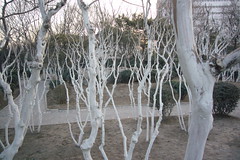
I call the Norway Maple (Acer platanoides) the Purple Loosestrife of or our hardwood forests. Silently invading our woodlots, it is replicating and efficiently eliminating native species. While the media discusses the issues of tree preservation and planting, there are issues of a tree invasion that are not being addressed. Because of this, I feel compelled to write this letter regarding the commonly overused Norway. While we need to protect and promote our forest canopy, we also need to understand that not every tree is sacred and decisions must be made to remove invasive species allowing for continued future forest diversity.
When I recently read about the Dundas tree count (Dundas Star, June 15, 2007 which I am shamefully not a part of), I recalled admiring the strength of conviction Julia Kollek and her volunteers have for promoting a long-term strategy for our urban trees. Dundas trees are getting old and are declining. Strategies need to be developed to map out how trees will be replaced and managed. I also started thinking about species diversity and common misconceptions regarding street trees and urban planting. I thought about the abundance of Norway maples on our historic streets and wanted to discuss why our previous (and perhaps continuing) urban planting methods are the detriment to our forests.
We live in a unique setting, the reason that so many of us love this region. We have the Niagara Escarpment, a world recognized UNESCO Biosphere Reserve, the RBG lands (including Cootes Paradise), and the diverse forest pockets of the Dundas Valley Conservation area. This is what encompasses us, inspires us, and we all reap the benefits of this intricate combination. I think it’s Southern Ontario’s best kept secret.
Unfortunately, our 20th century tree planting practices have ensnared us in loop of planting exotic trees while destroying our own forest diversity. From my walks along the Niagara Escarpment (and this is by no means a scientific analysis, merely observation) and the local forests, I notice how much of an impact the Norway (other species too, but the Norway is the for now my main target) is having on our natural vegetation systems. It is slowly naturalizing and dominating our native hardwoods. We started the exotic seed source – it was largely carried from our urban trees and parks. Who hasn’t pulled out the many seedlings of the Norway from their garden? The prolific seedlings, transported by winds, animals (including humans), and birds, are infesting local forests, hindering native groundcovers, and ultimately the growth of native hardwoods. People need to know that despite it having a trunk and leaves, this tree is severely impacting our deciduous forests.
Why plant the Norway Maple? There are so many other native species that better suit our location. Problems with the Norway: it has shallow roots causing an arid root infested planting bed; the root (and leaves) emit toxins to prevent most living things from growing beneath it (except it’s own seedlings) hindering this species to have a legitimate use in the cultured landscape.
Why do people plant it? Because it is fast growing, provides shade quickly, tolerates urban conditions, and to some it looks attractive. However people seldom realize the dark legacy when standing there with the salesperson at the nursery. I feel the landscape industry sometimes sells without responsibility. Should we start selling and planting Purple Loosestrife or Garlic Mustard since they also do well in our wetlands and forests?
I suggest an outright ban on selling or planting of the Norway Maple or any related variety (including the ubiquitous suburban tree the ‘Crimson King’). Nurseries also have a role in promoting responsible planting.
From all levels of government, a policy needs to be created. One which promotes the removal of Norways (not all at once! but slowly - with a plan) while hardily replacing with native species. Hopefully the tree count initiative not only represents pure canopy and condition, but also endeavours to evaluate invasive potential and possible recommendations for future removal and replacement. Let’s not get ourselves trapped by the notion of planting native species, but at the same time witnessing our native forests slowly being decimated. This is exactly what is happening in most Cities. The forestry department wants native vegetation, but does nothing to eliminate the potential Norway seed source. This situation is often caused by a lack of political will, budget constraints, and a misunderstanding by the public.
Don’t misunderstand me, I am a strong tree advocate, but tree protection, like any task, should not be without careful forethought of species selection and weighing it against future impact. Unfortunately not every tree is sacred and thoughtful but decisive management is sometimes warranted.







